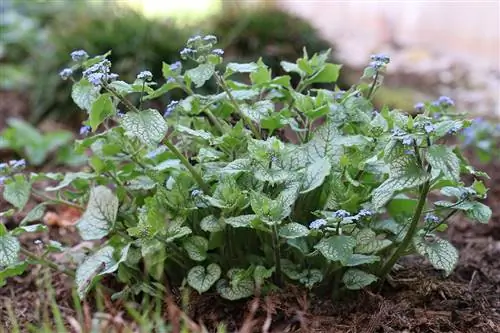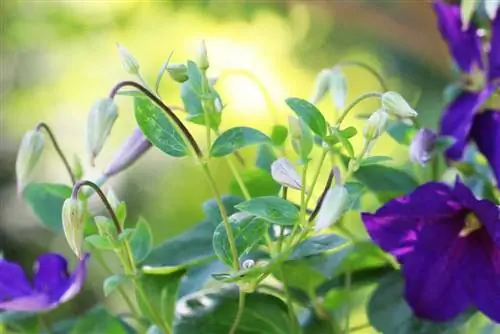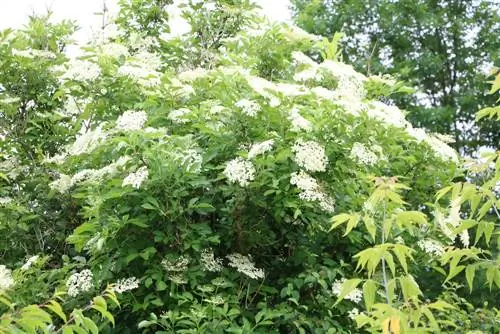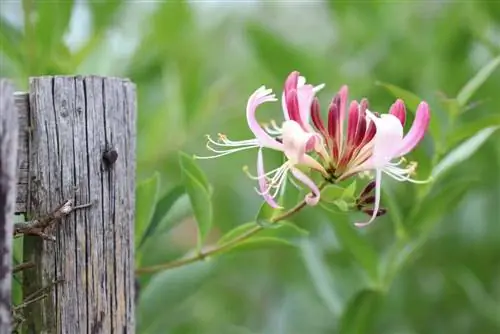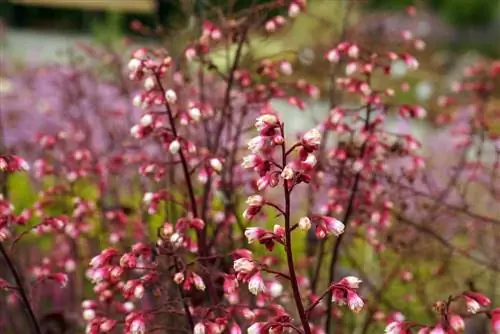- Author admin [email protected].
- Public 2023-12-17 03:39.
- Last modified 2025-06-01 06:48.
On a shady balcony you are protected from the hot summer sun without a parasol or awning. In addition, the shady balcony can become a green oasis by choosing suitable balcony plants. More decorative flowering plants thrive on a shady balcony than expected. This is how you can transform a shady balcony into a blooming paradise. A shady balcony not only offers a cozy spot in the fresh air, but you also save on the parasol and therefore have more space for balcony furniture, potted plants and flower boxes.
Varieties
If you want to create a green oasis on a shady balcony, you should use balcony plants that thrive particularly well in the shade. Well-chosen flowering plants can add colorful splashes of color to shady balconies. Balcony plants for shady locations can bloom just as luxuriantly as sun-loving geraniums. A successful balcony planting can beautify the appearance of the entire building.
The numerous flowering and green plants that are particularly suitable for shady balconies include
- Begonias
- Edellieschen
- bleeding hearts
- Forget-me-not
- Ivy
- Asparagus
Begonias
Begonias are very attractive balcony plants with colorful flowers that are shaped like small florets. They come from the tropics and subtropics and grow in shady places. They bloom from April to September, so you can add a colorful accent to your green balcony with begonias throughout the season. The perennial plants are available in the flowering colors yellow, white, pink and purple. The root tubers can overwinter in the cellar and sprout again in spring.
- Growth height: 30 to 40 cm
- Watering: medium water requirement, avoid waterlogging
- Fertilize: every one to two weeks with liquid fertilizer
Edellieschen
The Edellieschen are the perfect version of the hard-working Lieschen. Because of their beautiful colors, the plants have been a popular balcony greenery for more than two centuries. The noble lilies, which are available in many flowering colors such as pink, purple and white, thrive in the shade and can be grown in pots or in flower boxes. They bloom from May to October and can overwinter at room temperatures.
- Growth height: 30 to 40 cm
- Watering: medium water requirement
- Fertilize: in small quantities every two weeks during the summer months
Tip:
Removing the wilted flowers promotes the formation of new flowers. If flowering subsides, the plant should be trimmed back slightly. Pruning can achieve a shapely and dense growth.
bleeding hearts
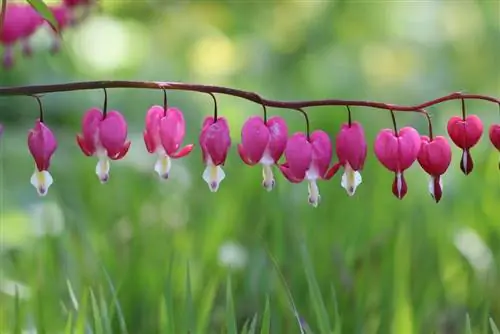
Flourishing hearts, whose natural home is the tropics of Asia and South America, were already popular ornamental plants in our part of the world in the Biedermeier period. Because they grow in the shade, it is particularly stylish to use them to green the shady balconies of Wilhelminian style houses. Bleeding hearts are suitable for flower pots and balcony boxes. In spring and summer they enchant viewers with hanging, red and white flowers. The perennial plants can overwinter indoors.
- Growth height: up to 90 cm
- Watering: medium water requirement
- Fertilize: every two weeks
A similar plant is the fuchsia, which can grow up to 1.30 meters high and blooms red-violet or blue.
Forget-me-not
The forget-me-not grows along the streams of shady forests. Of the approximately 50 known varieties, some are also used as ornamental plants and can be planted on shady balconies. From March to June, the forget-me-not delights viewers with pretty, bright light blue flowers.
- Growth height: up to almost 50 cm
- Water requirement: medium
- Fertilize: little
Ivy

Ivy is particularly suitable for adding greenery to shady balconies. It is hardy and can decorate the balcony all year round. The root climber can grow in planters or balcony boxes. It offers a natural privacy screen on trellises that are attached to the sides of the balcony. The meter-long tendrils can also grow horizontally across the trellis. Whitish to yellow-green flowers appear on older plants and bloom from September to October. During winter, the ivy on the balcony can be watered a little on frost-free days. To protect the cold-sensitive roots, it is recommended to cover the planter in frost protection film.
- Growth: tendrils up to 20 meters long
- Watering: medium water requirement
- Fertilize: little
Asparagus
Asparagus, known as a green plant, is an asparagus plant and is therefore also called ornamental asparagus. The Asparagus can be planted on the balcony from the end of May, when the last frost has passed. Its delicate, needle-shaped leaves quickly turn yellow and fall out in direct sunlight. But Asparagus can provide greenery on shady balconies throughout the summer season. It grows particularly well in light rain and high humidity. From spring it gets new shoots and becomes stronger. It can be combined very well with other plants in balcony boxes, giving the entire planting a relaxed look. Its shoots, which grow up to one meter long, can easily be cut to the desired length. Asparagus can overwinter indoors. Older plants may produce small white flowers. The flowering time of Asparagus is in early summer.
- Growth: shoots about one meter long
- Watering: keep evenly moist, avoid waterlogging, lower water requirement in winter
- Fertilize: every eight weeks during the summer months
Frequently asked questions
Are there any special features when caring for balcony plants growing in the shade?
Shade plants require slightly less water, there is no need for frequent watering to keep the soil moist.
Can balconies that sometimes have a bit of sun shine with shade plants?
Most shade plants are suitable for shade and partial shade. So every now and then a ray of sunshine can fall on them.
Can the shade plants also be combined with balcony plants that need sun?
Balcony plants that thrive in shady locations can be combined with plants that grow in both sun and shade. One such plant is the primrose.
What you should know about shade-loving balcony plants in brief
If planted correctly, shaded locations turn out to be an advantage on the balcony and should by no means be considered unfavorable. On the contrary, there are often situations in which the balcony gardener tries to create artificial shade in order to protect his protégés from too intense sunlight. A variety of plants prefer low-light growth areas anyway, and others quickly get used to only spending part of the day in the sun.
On hot summer days, shady balconies become a cool and refreshing oasis that also offers restful impressions to the eye. The green of the leafy plants, which are particularly lush here, has a calming effect. The foliage colors of the variegated forms show the strongest expression in light partial shade, and many other plants also develop the most intense colors in locations that are not constantly exposed to sunlight. Since evaporation remains low in the shade, moisture-loving plants find optimal growth conditions here. By selecting suitable plants, unique communities are created that bring a natural element to the balcony.
Tip:
Be aware of shade types! Many plants like to be shaded in only two parts, while others only develop their full beauty when they are in an angle that is constantly protected from sunlight. In locations that never benefit from sunlight, only true shade plants should be cultivated.
Half plants for the balcony shade
- Ornamental tobacco - Nicotiana (upright growing)
- Dahlia - Dahlia hybrids (upright growing)
- Jerker Flower - Mimulus Hybrid (upright growing)
- Male faithful - Lobelia erinus (upright growing), Lobelia Richardii (hanging)
- Fan flower - Scavola saligna (hanging)
- Leadwort - Plumbago (potted plant)
- African Lily - Agapanthus (potted plant)
- Angel Trumpet - Brugmansia (potted plant)
- Violet bush - Iochroma cyaneum (potted plant)
Tips for speed readers
- A number of attractive green and flowering plants are suitable for shady balconies.
- The flowering plants include the noble lily, the petunia and the bleeding heart.
- For lush flowering, it is recommended to fertilize lightly every two weeks.
- Asparagus placed between the flowering plants has a very decorative effect.
- Ivy trellises can be used to create a natural privacy screen on shady balconies.


